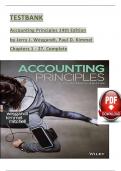Exam (elaborations)
TEST BANK For Accounting Principles, 14th Edition by Jerry J. Weygandt, Paul D. Kimmel, Verified Chapters 1 - 27, Complete Newest Version
TEST BANK For Accounting Principles, 14th Edition by Jerry J. Weygandt, Paul D. Kimmel, Verified Chapters 1 - 27, Complete Newest Version TEST BANK For Accounting Principles, 14th Edition by Jerry J. Weygandt, Paul D. Kimmel, Verified Chapters 1 - 27, Complete Newest Version TEST BANK For Accountin...
[Show more]



